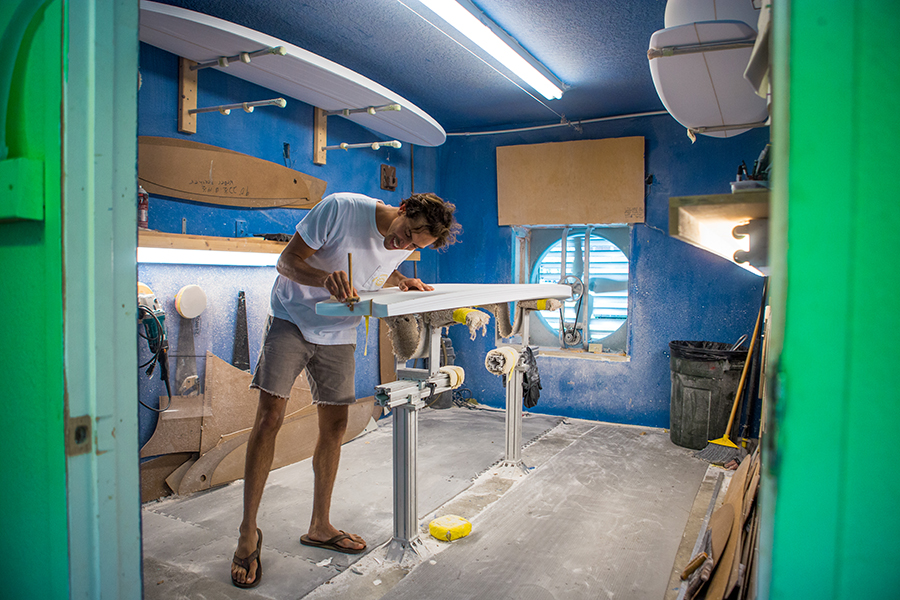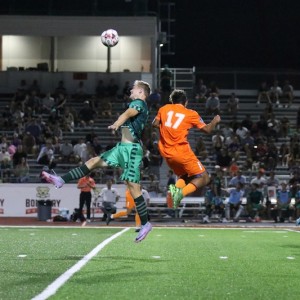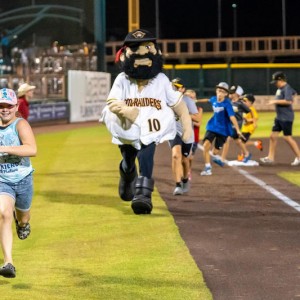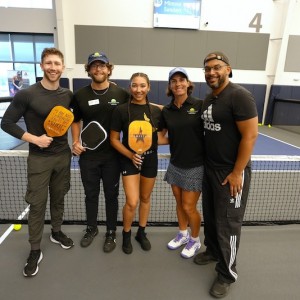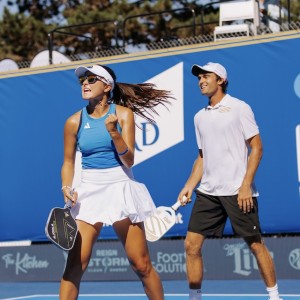Bret Telinger has spent most of his life bowing down to the wave gods, making offerings in the form of masterfully hand-shaped surfboards crafted with an eye towards surfing’s radical history. Board-shaping by hand taps into surf culture of the 1950s, an era of Dogtown shredders and beach-bleached hair that mimicked the frothy swells on which they rode. The hands-on, experimental nature of hand-shaping molded the sport as a whole. Telinger invited SRQ into his Sarasota studio as he shaped and glassed a new fish, hands gliding over the smooth undulated swell of the board’s curved barel, carving the short twin-finned surfboard into life.
SRQ: How did this all start? When did you begin making surfboards? Telinger: I was in about seventh or eighth grade and I was in the library at school and I picked up some random book and these guys were making surfboards. I just thought it was really cool. My aunt knew this guy Juan Rodriguez—he’s been building boards here in town for the last 50 years or so. I went to a surf contest with my dad and my dad was on the beach drinking beers and he looks over his shoulder and it’s Juan, and they started talking. My dad told him that I was dying to make surfboards. A week later, I was in there sweeping up his shop (One World Surf). I did that throughout high school and then I just decided, since my parents have this little garage, why not just do it myself. I got really lucky. Juan is pretty rare in the fact that he does so many different things—I was able to get a taste of every aspect of the process. He specializes in these wood fins and reproducing certain types of fins that you can’t get anymore from the ‘60s and ‘70s. He’s pretty well known throughout California with some of the founding fathers of surfing. I was a nobody who was able to make fins for somebody that is somebody.
Do you see Rodriguez as a mentor or a teacher, or are you kind of self-taught? It’s both. Juan wasn’t really that good of a teacher; he was good at enforcing the idea that you have to do the best job that you can, and he set the bar really high. He’s a perfectionist. If you don’t do it right, don’t do it at all. I started to learn a lot more when I started making mistakes.
Can people tell the difference between one of his boards and one of yours? It’s kind of funny because we’re both really interested in the same type of surfboards. Working with him sowed the seeds to realize that I really like what he was into—boards that were made in the ’60s and ‘70s, the transition period of surfing. The trained eye can definitely see the difference between who made what board. I’ll let people come into my studio that don’t have any shaping experience and let them use my tools and go for it. It’s fun because I can help them and they can help me. Like there’s this kid who comes in here now and I try to be kind of intimidating because that’s the way Juan was to me. But I also try and have fun. I usually give them a little bit of direction and then let them go. Then when they start to go wrong and drift away, I straighten them back out.
You mostly make custom boards for people now. In what styles do you specialize? My passion is making long boards. Longboarding is kind of like dancing on a wave. All the kids are into short boards, which are kind of ugly if not done right. I also make fishes, which are typically a twin fin or a quad, and it’s a wider, rounder shape and usually a little bit shorter and has a swallowtail. It looks like a fish. I also make the fins. They’re made out of fiberglass. There are 36 layers of glass—it’s the messiest job ever. The surfboard itself starts out as a big piece of foam, then I mark the specs and trace it out and then you cut it out then glass it. Most of the time, people come to me through word of mouth. I’m not super big—I’m just big enough for me. I can make what I like doing and not have to do a lot of other things that I’m not passionate about. I do in between three and five boards a month—I could do more but I like where I am at right now. It’s given me the freedom to say, “I like it this way. I don’t do things that way.” I specialize in certain things—like I can’t really draw, so the way that I do art on my boards is through resin.
Do you consider yourself to be an artisan—do you see yourself as being part of a larger art culture? I do in a way. Recently, there’s been more awareness in the surf industry of people who are specializing in making boards by hand, that it’s a larger part of surfing culture and it needs to be protected. You’re also providing a service for somebody—you’re making something for them to go out and have fun on. The way that the design comes in is that I look back to things from the past and see where they’ve gotten their ideas from and then I experiment to see if they work or not. I take that and build upon my own ideas. Surfing keeps evolving, so I’ve gone back to where it started to figure out where it could have gone. I made three boards that are based on three really well-known shaper’s styles—they represent fundamental changes in surfing to me. The first one I made was based on Dale Velzy’s shape—this is my best interpretation of what he did. If you look at boards in the ‘50s and early ‘60s, this was the style. Velzy is kind of the pioneer of the modern surf industry: he took these guys under his wing who ended up being well-known board builders—Hap Jacobs, Donald Takayama, Bing Copeland—all of whom I was able to have a hand in making fins for through Juan. The second board is supposed to be off of a [Bob] Simmons, who took direction from naval design, making the board like a boat hull. To me, it’s a pretty crucial element. The third board is a George Greenough. In the ‘70s, he was like Kelly Slater (the king of surfing now, an 11-time world champion) and so he was ripping on these knee boards—this is a knee board, which is what started modern surfing, with the radical turns you could do on a knee board—that’s when everything changed with design. Fins, materials, flexibility. This is a little bit of history right here.
Why Gum Surfboards? How did you land on that name? It’s like a brainchild for me—it symbolizes a lot of different things. It represents kind of how I know people and what that’s done for me: it’s been like a glue that has held me together. It’s also the connection between the past and the present. These boards represent the past in the present. And the name almost chose me. I first called my boards Reflection and I was just kind of over the name and the logo, I didn’t really have a direction. My friend and I started talking and brainstorming and he was drawing something out and he took one of the letters and made it into a G. It just sort of morphed into Gum and we were like, “That’s it.” It was like a firework of ideas and it just kept going.





